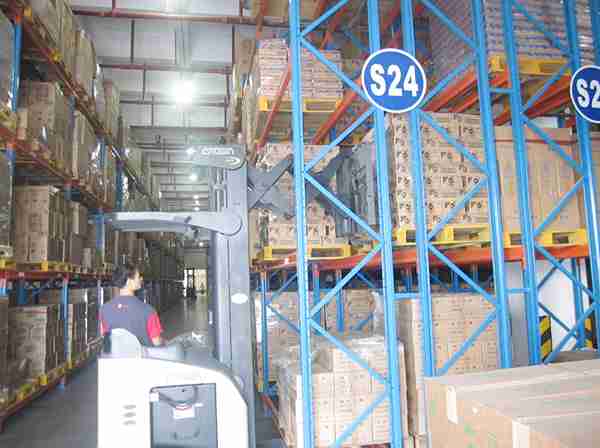📐 "First 50 Enterprise Queries Get Custom 3D Warehouse Design" Plan

Introduction
In the fast-paced world of warehouse logistics, double deep racking systems have become a cornerstone for maximizing storage density. However, without a rigorous rack inspection double deep system protocol, these systems can pose serious safety risks. This guide provides a comprehensive, step-by-step approach to inspecting double deep racking, ensuring compliance, preventing failures, and optimizing warehouse operations.
For warehouse managers, safety inspectors, and logistics professionals, mastering rack inspection double deep system best practices is essential for minimizing downtime, avoiding costly accidents, and extending equipment lifespan.

1. Understanding the Double Deep Racking System
Before diving into rack inspection double deep system procedures, it’s crucial to grasp how these systems function and why they require specialized attention.
1.1 What Makes Double Deep Racking Unique?
Unlike single-deep setups, double deep racking systems store pallets two-deep, requiring narrow-aisle forklifts (reach trucks) for retrieval. This design boosts storage capacity by up to 40%, making it ideal for high-volume warehouses.
1.2 Key Components Requiring Regular Rack Inspection
A thorough rack inspection double deep system assessment must examine:
- Uprights (Frames) – Vertical supports bearing the system’s weight.
- Beams – Horizontal load-bearing arms.
- Wire Decking – Prevents pallets from slipping.
- Baseplates & Anchors – Ensure stability on uneven floors.
- Row Spacers – Maintain consistent aisle widths.
Understanding these components helps inspectors identify early signs of wear, misalignment, or damage.
2. Why Rack Inspection for Double Deep Systems is Non-Negotiable
Neglecting rack inspection double deep system protocols can lead to:
- Catastrophic rack collapses, endangering workers.
- Regulatory violations (OSHA, RMI, EN 15635).
- Costly operational disruptions from unplanned repairs.
2.1 Industry Standards Governing Rack Inspections
- OSHA 1910.176(b) – Mandates safe storage practices.
- RMI (Rack Manufacturers Institute) Guidelines – Recommends professional inspections annually and weekly visual checks.
- EN 15635 (Europe) – Requires documented inspections at set intervals.
3. Step-by-Step Rack Inspection for Double Deep Systems
3.1 Preparing for a Double Deep Rack Inspection
- Review past inspection reports to track recurring issues.
- Ensure proper lighting for accurate damage detection.
- Use a calibrated torque wrench to check bolt tightness.
3.2 Structural Integrity Checks
3.2.1 Upright Inspection
- Look for dents exceeding ½” depth – these compromise load capacity.
- Check for rust or corrosion, especially in humid environments.
- Verify baseplate security – loose anchors destabilize the entire system.
3.2.2 Beam & Connector Examination
- Inspect beam ends for deformation from forklift impacts.
- Ensure locking mechanisms are fully engaged – a common failure point.
- Measure beam deflection – bending beyond 1/360 of span length requires replacement.
3.2.3 Load Capacity Verification
- Confirm weight limits per level – overloading is a leading cause of failure.
- Check pallet supports for sagging or cracks.
3.3 Floor & Alignment Assessment
- Uneven floors cause rack misalignment, increasing stress on components.
- Use a laser level – uprights should not tilt beyond 1/8″ per 10 ft.
3.4 Forklift Impact Damage Evaluation
- Forklifts cause 60% of rack damage in warehouses.
- Key signs of impact:
- Deep scratches or gouges on uprights.
- Bent beam connectors.
- Dislodged safety pins.
3.5 Documentation & Corrective Actions
- Photograph all damage for records.
- Classify severity (minor, moderate, critical).
- Prioritize repairs – critical issues demand immediate action.
4. Most Common Issues Found During Rack Inspections
4.1 Beam Overloading & Deflection
- Excessive bending indicates weight limits are being exceeded.
- Solution: Redistribute loads or upgrade beam capacity.
4.2 Upright Column Damage
- Dents deeper than ½” can lead to sudden collapses.
- Solution: Replace damaged uprights immediately.
4.3 Missing or Damaged Safety Components
- Loose beam locks increase collapse risks.
- Solution: Replace missing pins and enforce stricter inspection routines.
4.4 Corrosion in Humid Environments
- Rust weakens structural integrity over time.
- Solution: Apply anti-corrosion coatings or switch to galvanized steel.
5. Best Practices for Maintaining Double Deep Racking Systems
5.1 Implement a Strict Inspection Schedule
- Weekly visual checks by warehouse staff.
- Annual professional inspections by certified racking engineers.
5.2 Train Staff on Proper Handling
- Forklift operators should be trained on narrow-aisle maneuvering.
- Install protective barriers to minimize collision risks.
5.3 Use Protective Accessories
- Column guards absorb forklift impacts.
- End-of-aisle netting prevents pallets from falling.
5.4 Monitor Load Distribution
- Avoid uneven weight distribution – symmetrical loading is critical.
- Never exceed manufacturer-rated capacities.
6. When to Repair vs. Replace Racking Components
6.1 Repairable Damage
- Minor dents or scratches can often be reinforced.
- Loose bolts should be tightened immediately.
6.2 Irreparable Damage (Requires Replacement)
- Cracked or severely bent uprights.
- Beams with visible fractures or warping.
7. Essential Tools for Effective Rack Inspections
- Laser levels for precise alignment checks.
- Ultrasonic thickness gauges to detect hidden corrosion.
- Digital torque wrenches for accurate bolt tensioning.
8. Free Downloadable Rack Inspection Checklist
[Insert link to a free double deep racking inspection checklist for readers.]
9. Conclusion
A meticulous rack inspection double deep system routine is the backbone of warehouse safety and efficiency. By following this guide, businesses can prevent accidents, comply with regulations, and maximize storage performance.
Proactive maintenance, staff training, and timely repairs ensure that double deep racking systems remain reliable for years.
10. Frequently Asked Questions (FAQs)
Q1: How often should a rack inspection double deep system be performed?
- Weekly visual checks by staff and annual professional inspections are mandatory.
Q2: What’s the biggest risk of skipping rack inspections?
- Catastrophic rack collapses, leading to injuries, fatalities, and costly lawsuits.
Q3: Can a dented upright be repaired, or must it be replaced?
- Dents deeper than ½” require replacement – smaller dents may be reinforced.
Q4: How can forklift damage be minimized in double deep systems?
- Install impact guards, train operators, and enforce speed limits.
Q5: Are there automated tools for rack inspections?
- Yes, IoT sensors and warehouse management software (WMS) can track real-time damage.




